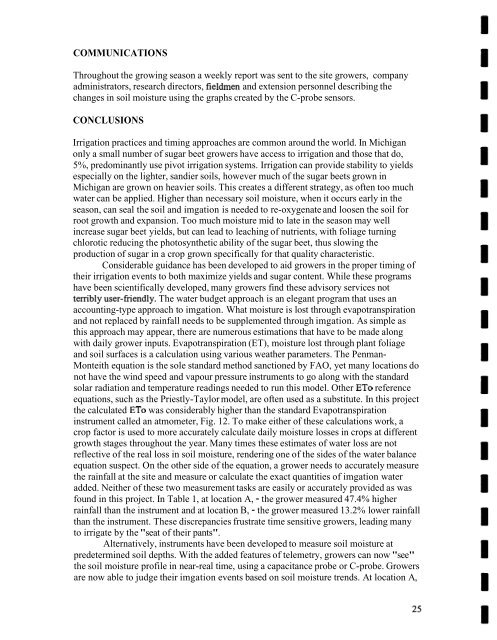ontario sugar beet growers - Atrium - University of Guelph
ontario sugar beet growers - Atrium - University of Guelph
ontario sugar beet growers - Atrium - University of Guelph
You also want an ePaper? Increase the reach of your titles
YUMPU automatically turns print PDFs into web optimized ePapers that Google loves.
COMMUNICATIONS<br />
Throughout the growing season a weekly report was sent to the site <strong>growers</strong>, company<br />
administrators, research directors, fieldmen and extension personnel describing the<br />
changes in soil moisture using the graphs created by the C-probe sensors.<br />
CONCLUSIONS<br />
Irrigation practices and timing approaches are common around the world. In Michigan<br />
only a small number <strong>of</strong> <strong>sugar</strong> <strong>beet</strong> <strong>growers</strong> have access to irrigation and those that do,<br />
5%, predominantly use pivot irrigation systems. Irrigation can provide stability to yields<br />
especially on the lighter, sandier soils, however much <strong>of</strong> the <strong>sugar</strong> <strong>beet</strong>s grown in<br />
Michigan are grown on heavier soils. This creates a different strategy, as <strong>of</strong>ten too much<br />
water can be applied. Higher than necessary soil moisture, when it occurs early in the<br />
season, can seal the soil and imgation is needed to re-oxygenate and loosen the soil for<br />
root growth and expansion. Too much moisture mid to late in the season may well<br />
increase <strong>sugar</strong> <strong>beet</strong> yields, but can lead to leaching <strong>of</strong> nutrients, with foliage turning<br />
chlorotic reducing the photosynthetic ability <strong>of</strong> the <strong>sugar</strong> <strong>beet</strong>, thus slowing the<br />
production <strong>of</strong> <strong>sugar</strong> in a crop grown specifically for that quality characteristic.<br />
Considerable guidance has been developed to aid <strong>growers</strong> in the proper timing <strong>of</strong><br />
their irrigation events to both maximize yields and <strong>sugar</strong> content. While these programs<br />
have been scientifically developed, many <strong>growers</strong> find these advisory services not<br />
terribly user-fiendly. The water budget approach is an elegant program that uses an<br />
accounting-type approach to imgation. What moisture is lost through evapotranspiration<br />
and not replaced by rainfall needs to be supplemented through imgation. As simple as<br />
this approach may appear, there are numerous estimations that have to be made along<br />
with daily grower inputs. Evapotranspiration (ET), moisture lost through plant foliage<br />
and soil surfaces is a calculation using various weather parameters. The Penman-<br />
Monteith equation is the sole standard method sanctioned by FAO, yet many locations do<br />
not have the wind speed and vapour pressure instruments to go along with the standard<br />
solar radiation and temperature readings needed to run this model. Other ETo reference<br />
equations, such as the Priestly-Taylor model, are <strong>of</strong>ten used as a substitute. In this project<br />
the calculated ETo was considerably higher than the standard Evapotranspiration<br />
instrument called an atmometer, Fig. 12. To make either <strong>of</strong> these calculations work, a<br />
crop factor is used to more accurately calculate daily moisture losses in crops at different<br />
growth stages throughout the year. Many times these estimates <strong>of</strong> water loss are not<br />
reflective <strong>of</strong> the real loss in soil moisture, rendering one <strong>of</strong> the sides <strong>of</strong> the water balance<br />
equation suspect. On the other side <strong>of</strong> the equation, a grower needs to accurately measure<br />
the rainfall at the site and measure or calculate the exact quantities <strong>of</strong> imgation water<br />
added. Neither <strong>of</strong> these two measurement tasks are easily or accurately provided as was<br />
found in this project. In Table 1, at location A, - the grower measured 47.4% higher<br />
rainfall than the instrument and at location B, - the grower measured 13.2% lower rainfall<br />
than the instrument. These discrepancies frustrate time sensitive <strong>growers</strong>, leading many<br />
to irrigate by the "seat <strong>of</strong> their pants".<br />
Alternatively, instruments have been developed to measure soil moisture at<br />
predetermined soil depths. With the added features <strong>of</strong> telemetry, <strong>growers</strong> can now "see"<br />
the soil moisture pr<strong>of</strong>ile in near-real time, using a capacitance probe or C-probe. Growers<br />
are now able to judge their imgation events based on soil moisture trends. At location A,

















